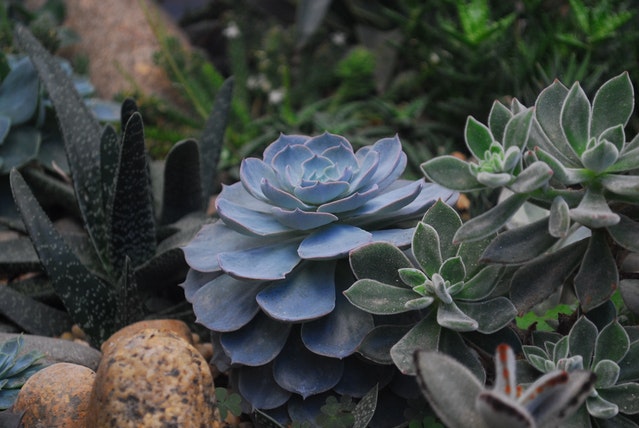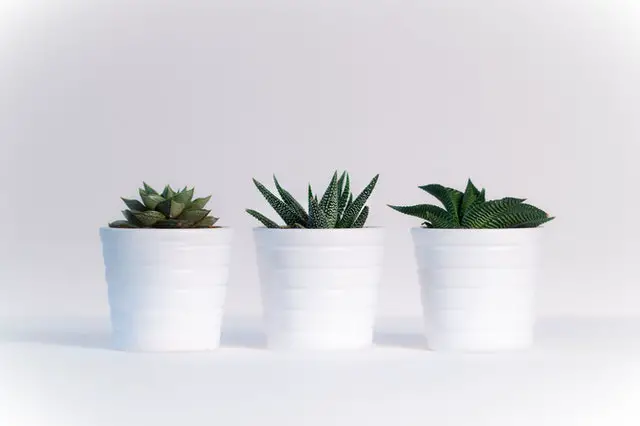Succulents are known for their small, compact size. Yet, people often wonder: how big do succulents get? The short answer is between six inches and two feet tall, on average. Yet, it mainly depends on the species and the plant’s growing environment.
Aside from the type of succulent, other factors that determine its size include light exposure, water availability, temperature, and soil type. By considering these elements, you can better ensure that your succulent is the exact size and shape that you desire
Because choosing the right type of succulents can get a bit overwhelming, we decided to lend a hand. We rounded up the four common factors that go into determining this plant’s growth rate. This way, you’ll have an easier time choosing the best succulents for your home and yard.
Let’s dive in.
How Big Do Succulents Get?

The world of succulents is brimming with species of different sizes and heights. They’re a popular choice among gardeners, both newbies and professionals, because they’re small and easy to manage. In fact, it’s one of the reasons people love using them as decorations indoors and outdoors.
The main deciding factor is the climate, then other things come into play, like soil and moisture.
On average, succulents grow to a range of six inches to almost two feet tall. However, some species are only an inch in diameter.
Then, on the farthest end of the scale, there’s the African native, Adansonia digitata, or Baobab tree. It’s been recorded to reach as high as 100 feet in height and nearly 40 feet in diameter!
This goes to show you the extreme diversity of these plant species. It also shows that their size depends on the care they’re given.
Those growing in favorable conditions will reach pretty impressive sizes. On the other hand, succulents growing in less than ideal conditions may not be able to grow as fast or as big.
1. Climate
Succulents growing in harsh climates are known for their particularly small size. In areas like these, there’s a substantial lack of moisture and nutrients in the soil.
As a result, succulents that grow in hot, dry areas aren’t given the resources they need to grow to their potential sizes. So, they learn to slow down their growth.
The opposite is also true. Succulents can’t tolerate frost and icy weather. The only two that can handle slightly cold weather conditions are the sempervivum and Sedum cacti and are considered exceptions to the rule.
Case in point, succulents thrive in moderate temperatures that range between 50℉ and 90℉. Therefore, another way to keep thriving and boost their growth rate is to protect them from extreme temperatures or sudden temperature changes.
2. Light

As a general rule, succulents enjoy being in bright, well-lit areas. Their thick, lush leaves and short roots allow them to be in the sun for hours.
Succulents that aren’t getting the light they need will appear paler, and their leaves will look like they’re sagging instead of being perky and upright. Still, some species prefer partial light, and will become sunburned if left in direct sunlight for long hours.
One example is the Rhipsalis. It prefers filtered sunlight and has adapted to living in the openings and slits of tree trunks rather than being in the soil. This way, it’s able to regulate the amount of sunlight they receive through the tree canopy.
Other types, such as the Cereus and the Opuntia, prefer full sunlight. These are typically found in the desert, where they’ve adapted to life in the harsh heat.
3. Soil
Most succulents prefer nutrient-rich, well-draining soil. You can always add some organic material to the soil to boost its nutrient content. Ingredients, such as sand, perlite, and gravel, make excellent additions because they promote water drainage as well.
Yet, avoid adding high amounts of peat moss or clay because they’re known for their high water retention. They don’t do well with soils that retain water because they usually lead to root rot and eventually kill off the plant.
One way to make sure you’re doing everything right by your plant is to keep an eye on the leaves. If the top leaves start to appear yellowish, this could be a sign of nutrient deficiency. If this is the case, consider mixing in additional nutrients to the soil to give it a nice boost.
Another option is repotting, which you should do every couple of years anyway. It’s a great way to provide your plant with fresh, fertile soil and give it some extra space to spread its roots.
4. Watering

Many people make the mistake of not giving succulents enough water because they’re categorized as drought-tolerant plants. Yet, you may be surprised to know that it’s actually possible to underwater them.
While they’re certainly capable of going for long periods without water, it doesn’t mean they should. Without the proper amount of hydration, they’ll be forced to become dormant, where they grow extremely slowly, if at all.
Yet, it’s overwatering that affects them more because it leads to root rot, as mentioned above. This fungal infection spreads quickly among the roots, eventually killing off the entire plant.
Again, to gauge whether or not you’re giving your plant the right amount of water, look at the leaves. If the bottom leaves are yellowing, then this is a sign you’re overwatering your succulents.
Summary
Having a general idea of the size of the plants you’re growing helps you plan accordingly. This way, you don’t end up with a plant that’s bigger than you expected, especially if you’re short on space.
So, when in doubt, use our handy guide on ‘how big do succulents get?’ Equipped with the right information, you’ll be able to estimate the size of your succulents as they grow and mature.
Learn more about succulents:
Frequently Asked Questions
Check out these common questions about succulent maintenance and growth.
Do succulents grow and get bigger?
Yes, they do, but each in its own way.
For example, some species grow bigger by producing pups, or miniature versions of themselves.
Others can grow into huge plants, but these are usually outdoor species. The indoor types grow at a slower rate.
Just to give you an example of their different sizes, we’ll start with the smallest succulent in the world. Known as the Blossfeldia liliputana, this tiny plant measures nearly half an inch in diameter when fully mature.
Another tiny cactus is the Lithops. At maturity, it can reach about 1.5 inches in diameter.
Because of their small size, these two species grow in clumps that help each other thrive in harsh conditions. So, rather than having one large plant, these typically grow together as a group of smaller cacti.
What size pot do potted succulents need?
In general, potted succulents grow to about 3–3.5 inches in diameter. So, you’ll need the pot about 3.5–4 inches across.
Always make sure you pick a pot suitable to the size of the succulent. Don’t be in a rush to buy a bigger pot because it’ll hold excess water, which can cause root rot.
If you’re growing several succulents in one pot, place them about an inch apart to provide each one with adequate space to grow. Also, give them about half an inch of space from the edge of the pot as well.
Do small succulents get bigger?
The one factor that all succulents have in common is that they’re slow growers, especially in the beginning. Most species take a year to grow an inch or two.
Yet, they do grow nonetheless, even those adorable mini succulents.
The best thing you can do is provide them with the proper growing conditions that will keep them healthy and happy.

Hey, I’m Lisa and I’ve been an avid gardener for over 30 years. I love writing, talking and living in the garden! Feel free to connect with me on my socials below

